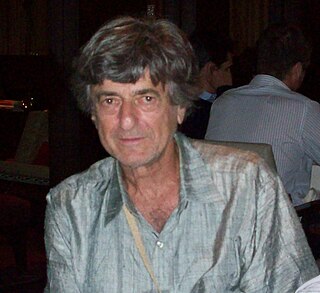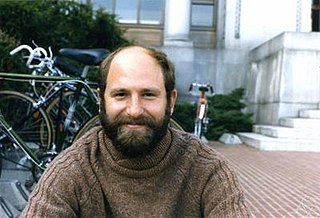
In mathematics, differential topology is the field dealing with the topological properties and smooth properties of smooth manifolds. In this sense differential topology is distinct from the closely related field of differential geometry, which concerns the geometric properties of smooth manifolds, including notions of size, distance, and rigid shape. By comparison differential topology is concerned with coarser properties, such as the number of holes in a manifold, its homotopy type, or the topology of its diffeomorphism group. Because many of these coarser properties may be captured algebraically, differential topology has strong links to algebraic topology.

In mathematics, a dynamical system is a system in which a function describes the time dependence of a point in a geometrical space. Examples include the mathematical models that describe the swinging of a clock pendulum, the flow of water in a pipe, and the number of fish each springtime in a lake.

Stephen Smale is an American mathematician, known for his research in topology, dynamical systems and mathematical economics. He was awarded the Fields Medal in 1966 and spent more than three decades on the mathematics faculty of the University of California, Berkeley.

Raoul Bott was a Hungarian-American mathematician known for numerous basic contributions to geometry in its broad sense. He is best known for his Bott periodicity theorem, the Morse–Bott functions which he used in this context, and the Borel–Bott–Weil theorem.

Solomon Lefschetz was an American mathematician who did fundamental work on algebraic topology, its applications to algebraic geometry, and the theory of non-linear ordinary differential equations.
In mathematics, particularly in differential topology, there are two Whitney embedding theorems, named after Hassler Whitney:

In differential topology, sphere eversion is the process of turning a sphere inside out in a three-dimensional space. Remarkably, it is possible to smoothly and continuously turn a sphere inside out in this way without cutting or tearing it or creating any crease. This is surprising, both to non-mathematicians and to those who understand regular homotopy, and can be regarded as a veridical paradox; that is something that, while being true, on first glance seems false.

In mathematics, the homotopy principle is a very general way to solve partial differential equations (PDEs), and more generally partial differential relations (PDRs). The h-principle is good for underdetermined PDEs or PDRs, such as occur in the immersion problem, isometric immersion problem, fluid dynamics, and other areas.
The Leroy P. Steele Prizes are awarded every year by the American Mathematical Society, for distinguished research work and writing in the field of mathematics. Since 1993, there has been a formal division into three categories.

Jenny Harrison is a professor of mathematics at the University of California, Berkeley.

The Lorenz system is a system of ordinary differential equations first studied by Edward Lorenz. It is notable for having chaotic solutions for certain parameter values and initial conditions. In particular, the Lorenz attractor is a set of chaotic solutions of the Lorenz system. In popular media the "butterfly effect" stems from the real-world implications of the Lorenz attractor, i.e. that in any physical system, in the absence of perfect knowledge of the initial conditions, our ability to predict its future course will always fail. This underscores that physical systems can be completely deterministic and yet still be inherently unpredictable even in the absence of quantum effects. The shape of the Lorenz attractor itself, when plotted graphically, may also be seen to resemble a butterfly.

In mathematics, an immersion is a differentiable function between differentiable manifolds whose derivative is everywhere injective. Explicitly, f : M → N is an immersion if
In mathematics, topological dynamics is a branch of the theory of dynamical systems in which qualitative, asymptotic properties of dynamical systems are studied from the viewpoint of general topology.
In mathematics, the Schoenflies problem or Schoenflies theorem, of geometric topology is a sharpening of the Jordan curve theorem by Arthur Schoenflies. For Jordan curves in the plane it is often referred to as the Jordan–Schoenflies theorem.

Richard Sheldon Palais is a mathematician working in geometry who introduced the Principle of Symmetric Criticality, the Mostow–Palais theorem, the Lie–Palais theorem, the Morse–Palais lemma, and the Palais–Smale compactness condition.

Michael Ira Shub is an American mathematician who has done research into dynamical systems and the complexity of real number algorithms.
J. (Jean) François Trèves is a French mathematician, specializing in partial differential equations.
In mathematics, global analysis, also called analysis on manifolds, is the study of the global and topological properties of differential equations on manifolds and vector bundles. Global analysis uses techniques in infinite-dimensional manifold theory and topological spaces of mappings to classify behaviors of differential equations, particularly nonlinear differential equations. These spaces can include singularities and hence catastrophe theory is a part of global analysis. Optimization problems, such as finding geodesics on Riemannian manifolds, can be solved using differential equations so that the calculus of variations overlaps with global analysis. Global analysis finds application in physics in the study of dynamical systems and topological quantum field theory.

Robert Luke Devaney is an American mathematician, the Feld Family Professor of Teaching Excellence at Boston University. His research involves dynamical systems and fractals.

Steven "Steve" Morris Zelditch is an American mathematician, specializing in global analysis, complex geometry, and mathematical physics.














